Grow all year and let ‘em lay
The frost will kill without decay,
Once fixed up and hung real high
The renter eats that pesky fly
—Burt Whatcher
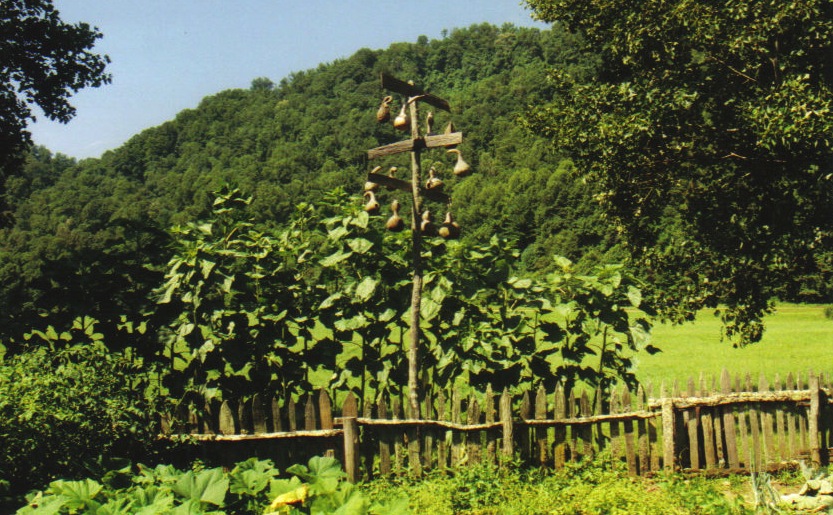
What’s the easiest way to build a birdhouse? Well I say let nature do it…or at least half of it.
Dried gourds have long made for simple and efficient birdhouses. Early native Americans understood that birds like purple martins and bluebirds were useful in keeping numbers of plant-harming insects low, not to mention mosquitoes and gnats. In years past martins were valued on the homestead for keeping hawks away from the family chickens that free-ranged nearby. The bluebird is also well known for its willingness to nest in close proximity to people. It goes without saying that helping beneficial birds to thrive near humans has always been a win-win situation—both for our pleasure, and for the good of our gardens. And hard-shelled gourds (Lagenaria siceraria) have played a big part in that symbiotic relationship. Although many kinds of modern birdhouses are on the market, many people still prefer the rustic allure of the traditional gourd houses.
Growing Your Birdhouse
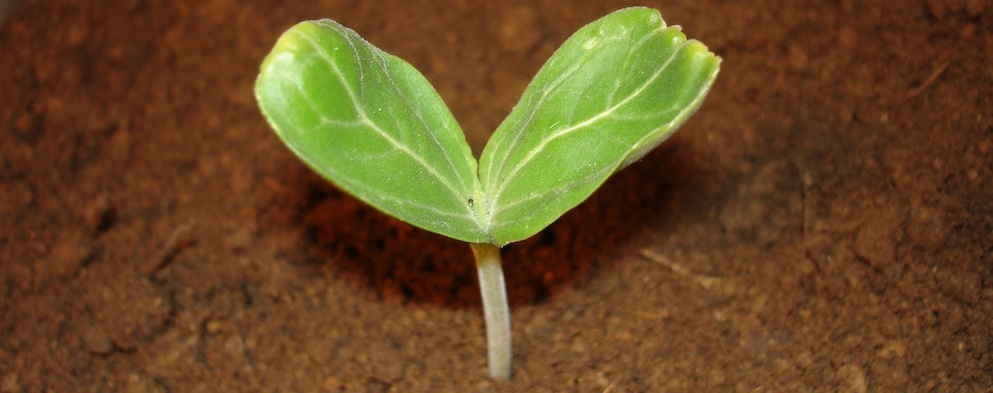
Gourd seeds may be started indoors a few weeks before the last frost date or planted directly in the soil in spring. Like many other members of the squash family, gourds relish a dark, fertile soil. As the season progresses, vines become aggressive climbers and can look very attractive growing on your garden fence throughout summer months. Once mature, each plant can bear up to a dozen gourds.
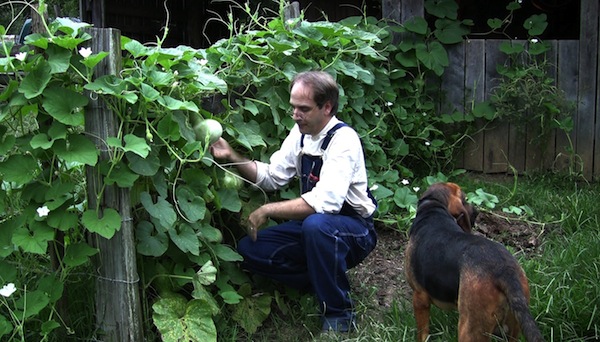
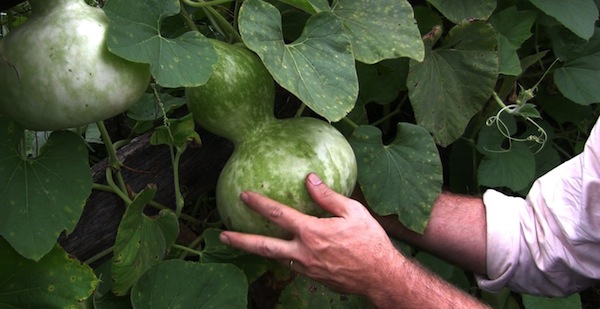
The cows tended to leave these green vines alone; I suppose they thought it either looked good or tasted bad
The best plan for harvesting your future birdhouses is to let the gourds dry on the dead vines past frost about this time of the year. Once they are completely brown in color and rattle when shaken, cut them from the vine and store them away in a dry place until you’re able to begin your birdhouse construction project.
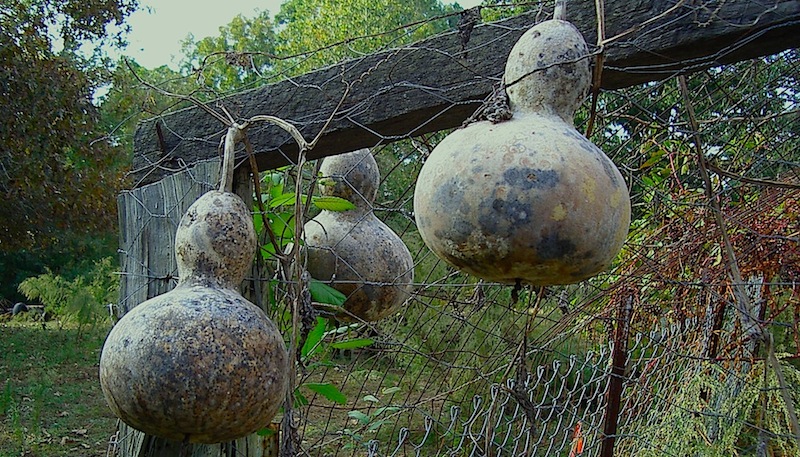
Hardly any better place for gourd growin’ than a chicken yard fence

Birdhouse Carpentry
Entrance holes for martin houses that are cut round should be from 1 & 3/4 inches up to 2 & 1/4 inches in diameter. Holes for bluebirds, however, should be smaller at 1 & 1/2 inches in diameter. Cut the holes with a sheet-rock saw, keyhole saw, or electric saber saw, then scrape out the dried seeds and membrane real good. Take a 1/4 inch bit and bore a couple of holes in the neck or top of the gourd for hanging. Drill several 1/4 inch holes in the bottom of the gourds to drain stray rain drops that accumulate during windblown rains. Some folks prefer to paint their gourds white in order to make them last longer; probably also makes ’em cooler for the inhabitants during hot summer months.
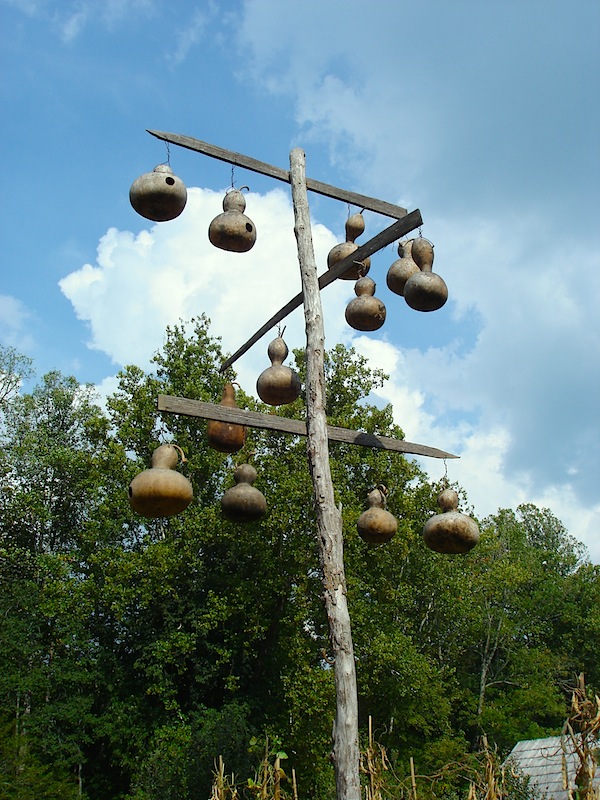
Almost nothing prettier up over your garden than this
Raising Your Gourds…The Second Time
Purple martins are social birds choosing to live close to each other in groups. One option for traditional purple martin housing is to hang several gourds from wooden crossbeams nailed at different angles on a central pole. For a natural look, use a straight, peeled locust tree for your pole. Keep gourd clusters at a distance from large trees to provide martins with a free flight path. Position poles so that entrance holes face away from prevailing winds and rains. Another option is to hang a series of nesting gourds about 18 inches to two feet apart from a single rope or wire line. The rope lines or pole housing should be high enough for the gourds to hang no lower than 12 feet off the ground. Hang the gourds from your crossbeams or rope line with nylon string or wire. Take gourds down once each year to clean out old nesting material and prepare for the next season. Replace gourds after two or three years if they begin to get too brittle. In other words, grow some more ever now and then.
Bluebirds, unlike martins, prefer to nest at a distance from other bluebird mated pairs. Single gourds may be hung from tree branches or on fence posts close by your garden, again, facing away from the direction of prevailing winds. Make sure the house is steadied in some way so as not to swing freely as do martin gourds. Bluebirds just can’t take that swinging for some reason. Once bluebirds have established housing as their own, the same breeding couple may raise several hatchlings in one season, often using the same gourd or house for as long as the pair live, provided it remains in good shape. Watch the nest closely so that you can clean out the old nesting material after each set of baby birds strikes out on their own.
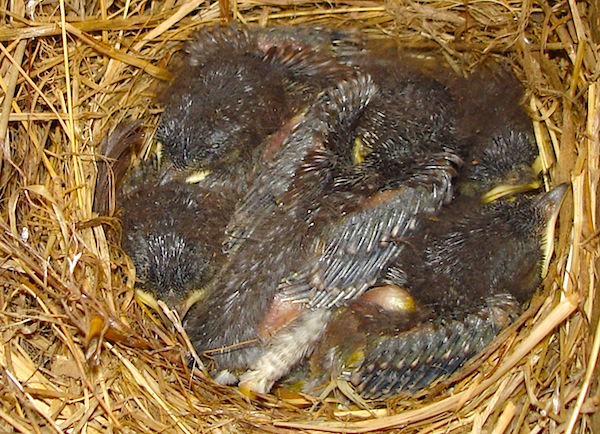
These baby bluebirds hate the cradle rocking about as much as the bough breaking.
If small predatory animals pose a problem to birds in your area (or the neighbor’s tomcat), consider lining the bottom of poles or posts that support your birdhouses with smooth sheet metal flashing placed high enough up to inhibit climbing attempts by cats, raccoons, or even snakes that relish the eggs of these beneficial birds. I’ve even had success against cats by wrapping the pole with enough barbwire to make ’em wonder if it was worth the trouble.
Gourds Are For the Birds
Next spring, plant some gourds on that old wooden fence and give beneficial birds in your yard a break the following year. Provide ‘em room and board that adds some rustic style to your garden spot, and they’ll pay back the favor in their own unique way.
(This article was written by Pa Mac and first published as “Traditional Gourd Birdhouses – For the Garden, and From the Garden” in the May 2006 issue of Tennessee Gardener Magazine, excerpted here with permission courtesy of State by State Gardening)
